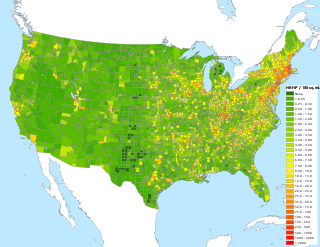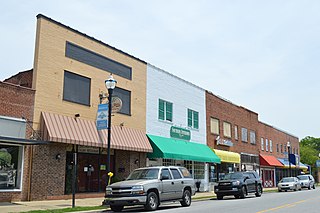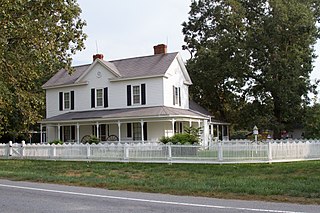
Mocksville is a town in Davie County, North Carolina, United States. The population was 5,900 at the 2020 census. I-40 leads west to Statesville and Hickory, and east to Winston-Salem and Greensboro. Route 64 heads east to Lexington, and west towards Statesville and Taylorsville. It is the county seat of Davie County.

Jesse Johnson Yeates was a Democratic U.S. Congressman from North Carolina between 1875 and 1881.

The National Register of Historic Places in the United States is a register including buildings, sites, structures, districts, and objects. The Register automatically includes all National Historic Landmarks as well as all historic areas administered by the U.S. National Park Service. Since its introduction in 1966, more than 97,000 separate listings have been added to the register.

This is a list of structures, sites, districts, and objects on the National Register of Historic Places in North Carolina:
Brinkleyville is an unincorporated community in Halifax County, North Carolina, United States. It is part of the Roanoke Rapids, North Carolina Micropolitan Statistical Area.

Cleveland Township is one of fourteen non-functioning county subdivisions (townships) in Rowan County, North Carolina that were established in 1868. The township had a population of 2,817 according to the 2010 census. The only incorporated municipality in Cleveland Township is the town of Cleveland. Residents are served by the Rowan–Salisbury School System and the township is home to Mt Ulla Elementary School.

The Edwards–Franklin House is a plantation house in the Southern United States located in Franklin Township, Surry County, North Carolina. It was built in 1799 by Gideon Edwards and was later occupied by congressional representative Meshack Franklin, brother of North Carolina governor Jesse Franklin (1820–1821). The house was restored by the Surry County Historical Society in 1973 and is open to visitors.

The Montford Area Historic District is a mainly residential neighborhood in Asheville, North Carolina that is included in the National Register of Historic Places.
Robinson House may refer to:

The J. Nelson Kelly House is a building in Grand Forks, North Dakota that was listed on the National Register of Historic Places in 1994. The property is also known as Lord Byron's Bed and Breakfast and denoted as 32 GF 1387. It was built or has other significance in 1897. When listed the property included the house as the one contributing building and also one non-contributing building, which is a relatively modern garage.

The Jesse R. Siler House is a historic house at 115 West Main Street in Franklin, North Carolina. It is prominently sited at the base of the hill on which most of the city is located. A two-story log structure was built on this site c. 1819, and expanded between 1820 and 1830 by Jesse Siler, a prominent early settler of the area. It was modified significantly over the 19th century, most notably receiving a prominent Greek Revival tetrastyle portico. It retains many interior features from Siler's period of modification, exhibiting transitional Georgian-Federal styling in its mantels.

Clement Geitner House is a historic home located at Hickory, Catawba County, North Carolina. It was built in 1882, and is a two-story, double pile brick dwelling on a stone foundation. It has a central hall plan and one-story full-width front porch. It has a large, 1+1⁄2-story brick veneer rear addition dated to the mid-20th century.
The Jesse Benbow House II is a historic house located near Oak Ridge, Guilford County, North Carolina.

Murfreesboro Historic District is a national historic district located at Murfreesboro, Hertford County, North Carolina. The district encompasses nine contributing buildings in the oldest section of the city of Murfreesboro. The buildings include notable examples of Greek Revival style architecture. They are the William Rea Store ; John Wheeler House birthplace of John H. Wheeler (1806-1882) and later home of Congressman Jesse Johnson Yeates (1829-1892); Myrick House ; Melrose home of Congressman William H. Murfree ; The Hertford Academy ; Roberts-Vaughan House ; Dr. Isaac Pipkin House ; Rose Bower ; and the Walter Reed House childhood home of Walter Reed.

John Wheeler House is a historic home located in the Murfreesboro Historic District at Murfreesboro, Hertford County, North Carolina. It was built about 1805, and is a two-story, three-bay, vernacular Federal-style Flemish bond brick dwelling with a central passage plan. The front facade features a later two-story pedimented portico. It was the birthplace of John H. Wheeler (1806-1882) and later home of Congressman Jesse Johnson Yeates (1829-1892).
Myrick–Yeates–Vaughan House, also known as the Yeates–Vaughan House, Uriah Vaughan Jr. House, and Sarah Vaughan House, was a historic home located at Murfreesboro, Hertford County, North Carolina. The "T"-plan house consisted of an earlier 1+1⁄2-story Federal style rear section with a two-story Greek Revival style front section. The Greek Revival was built between 1851 and 1855. It was owned by Congressman Jesse Johnson Yeates (1829-1892) during the 1870s. The house has been demolished.
Jesse Jackson House is a historic home located near Kinston, Lenoir County, North Carolina. It was built about 1840, and is a two-story, five-bay, Greek Revival style frame dwelling. It has a gable roof, sits on a brick foundation, and has flanking concave shouldered chimneys. The front facade features a one-story porch featuring a diminutive entablature supported by wooden pillars.
Jesse Fuller Jones House is a historic plantation house in Spring Green, Martin County, North Carolina. It dates to the first quarter of the 19th century and is a 2+1⁄2-story, four-bay, Federal-style frame dwelling. It has a gable roof and flanking exterior end chimneys. The house features handsomely detailed interior woodwork. Also on the property is a contributing smokehouse.

Jesse R. Moye House is a historic home located at Greenville, Pitt County, North Carolina. It was designed by architect Herbert Woodley Simpson and built in 1902. It is a 2+1⁄2-story, Queen Anne style frame dwelling with Colonial Revival style details. It has a large wraparound front porch, multiple projections, and multiple gable roofline.

Jesse Penny House and Outbuildings is a historic home and farm complex located near Raleigh, Wake County, North Carolina. The Penny House was built in 1890, and enlarged in 1900. It is a two-story, single pile, frame I-house with a one-story rear addition. It features a hip-roofed wraparound porch. Also on the property are the contributing well house, barn/garage, barn, chicken house, and picket fence.


















